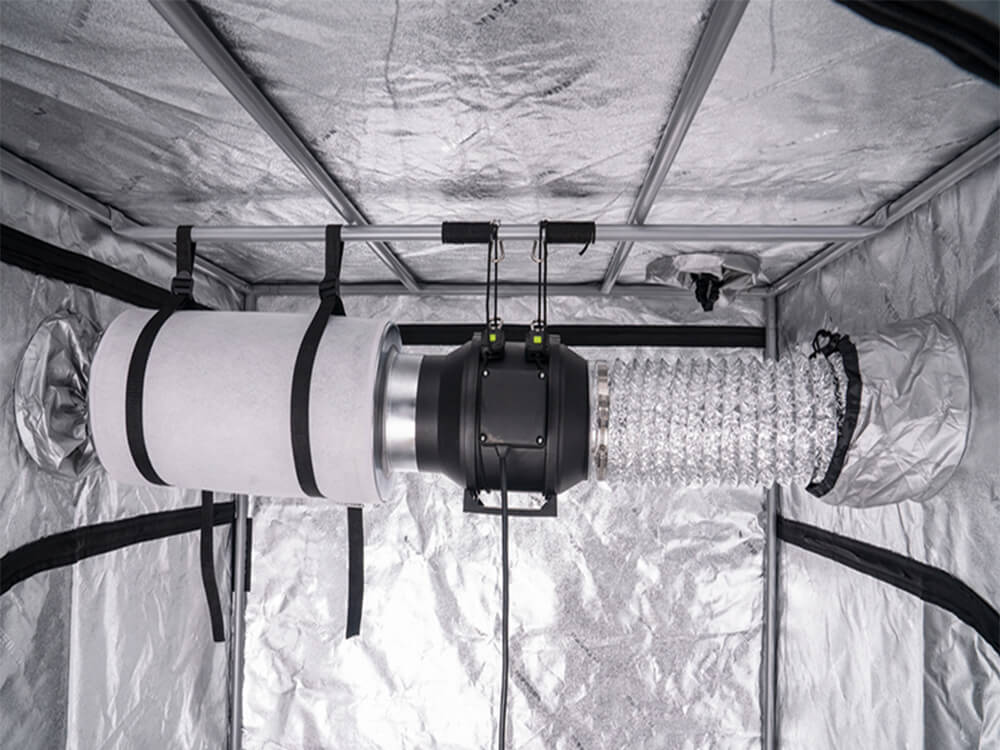🔥 Website for Sale - Contact Us
Security and discretion are often of utmost importance for indoor cannabis gardeners. Creating a covert cannabis indoor garden requires careful planning and execution to ensure that your grow room remains undetected and secure from prying eyes. One key aspect of maintaining a low-profile grow room is the proper use of carbon filters. Carbon filters play a vital role in controlling odors, which is essential in keeping your grow operation as discreet as possible. By effectively neutralizing the unmistakable smell of cannabis, you can significantly reduce the chances of your indoor garden being discovered. In this guide, we will delve into the role of carbon filters in maintaining a low-profile grow room, offering valuable insights and best practices for their placement and use.
I. Understanding Carbon Filters and Odor Control
A. The Basics of Carbon Filters
Carbon filters, also known as activated carbon filters or charcoal filters, are essential components in maintaining a discreet and low-profile cannabis grow room. The filters use activated carbon, a porous material with an extensive surface area, which effectively absorbs and traps odor-causing molecules. This absorption process neutralizes the distinctive smell of cannabis, ensuring the air leaving your grow room is odor-free.
B. How Carbon Filters Help Control Cannabis Odors
Carbon filters play a pivotal role in managing the pungent scent of cannabis plants. When air passes through the carbon filter, the activated carbon attracts and holds the odor molecules, preventing them from being released into the surrounding environment. This process is essential in maintaining a covert cannabis garden, as the smell of cannabis can be a dead giveaway for your indoor grow operation.
C. Choosing the Right Carbon Filter for Your Grow Room
The right carbon filter should be able to efficiently neutralize cannabis odors, while also being compatible with your grow room size and ventilation system.
- Airflow capacity: Ensure that the carbon filter’s airflow capacity matches your exhaust fan’s capacity to effectively remove odors from the grow room.
- Filter size: Choose a carbon filter that is the appropriate size for your grow room. Larger grow rooms may require bigger or multiple carbon filters to effectively neutralize odors.
- Lifespan: Activated carbon filters have a limited lifespan, which depends on their quality and usage. Invest in a high-quality carbon filter that offers an extended lifespan to minimize the need for frequent replacements.
By understanding the role of carbon filters in odor control and selecting the right filter for your grow room, you can effectively maintain a low-profile and secure cannabis cultivation space.
II. Where To Put Carbon Filter In Grow Room Best Practices
A. Near the Exhaust Fan or Ducting System
One of the most effective strategies for ensuring optimal odor control is by placing the carbon filter near the exhaust fan or ducting system. This placement is crucial for several reasons:
Maximizing Odor Capture: Positioning the carbon filter close to the exhaust fan or ducting system ensures that odor-filled air is filtered before being expelled from the grow room. As the air is drawn through the carbon filter, the activated carbon captures and neutralizes the odor-causing molecules. By placing the filter near the exhaust, you can maximize its effectiveness in capturing and neutralizing odors before they have a chance to escape your grow room.
Efficient Airflow: Proper airflow is essential for maintaining a healthy and discreet grow room. Placing the carbon filter near the exhaust fan or ducting system helps maintain efficient airflow, as the air moves through the filter and then directly out of the grow room. This setup not only aids in odor control but also ensures that fresh air is consistently circulated throughout the grow space, promoting healthy plant growth.
Easy Maintenance: Installing the carbon filter close to the exhaust fan or ducting system makes it more accessible for regular maintenance and cleaning. Regularly replacing the activated carbon when necessary, will help ensure that your grow room remains discreet and undetected.
B. Where to Put Carbon Filter in Grow Room: At the Highest Point
Another essential consideration when deciding where to put your carbon filter in the grow room is the vertical placement. Installing the carbon filter at the highest point has the following advantages.
Capturing Rising Odors: As odors tend to rise with heat, placing the carbon filter at the highest point in the grow room allows it to effectively capture and neutralize odors as they rise.
Better Air Circulation: Installing the carbon filter at the highest point in your grow room can also promote better air circulation. As the exhaust fan draws air through the filter and out of the grow space, fresh air is pulled into the room, creating a continuous flow of clean air. This circulation not only helps control odors but also supports healthy plant growth by providing fresh, oxygen-rich air.
Easy Integration with Ventilation System: Positioning the carbon filter at the highest point in your grow room often allows for easy integration with your existing ventilation system. Many grow room setups already have exhaust fans or ducting systems installed near the ceiling, making it simpler to connect your carbon filter.
In summary, when considering where to put your carbon filter in the grow room, placing it at the highest point offers several benefits, including effective odor capture, efficient use of space, better air circulation, and easy integration with your ventilation system.
C. Accessible for Maintenance and Replacement
When deciding where to put your carbon filter in the grow room, it’s crucial to consider the ease of maintenance and replacement. Ensuring that the carbon filter is easily accessible will help you maintain its effectiveness and extend its lifespan. Here are some advantages and tips for placing your carbon filter in an accessible location:
Easy Inspection and Cleaning: Regular inspection and cleaning of your carbon filter are essential for maintaining its odor-neutralizing capabilities. By placing the carbon filter in an easily accessible location within your grow room, you can quickly perform routine checks and clean the filter as needed, ensuring optimal performance and a discreet growing environment.
Reduced Downtime: When maintaining or replacing your carbon filter, it’s essential to minimize downtime in your grow room. By placing the filter in an accessible location, you can quickly perform maintenance tasks without disrupting the overall operation of your grow room. This minimizes the impact on your plants and ensures a consistent growing environment.
Safety Considerations: Working in confined spaces or at heights can be hazardous, especially when handling heavy equipment like carbon filters. Placing the carbon filter in an accessible location helps reduce the risk of accidents during maintenance or replacement.
In conclusion, considering accessibility for maintenance and replacement is crucial. By selecting a location that allows for easy inspection, cleaning, and timely replacement, you can maintain optimal odor control, reduce downtime, and ensure the safety of your grow room operation.
D. Where to Put Carbon Filter in Grow Room: Away from Water Sources and Direct Heat
Another key consideration when determining where to put your carbon filter in the grow room is to keep it away from water sources and direct heat.
Protecting Carbon Filter Lifespan: Exposure to water and high humidity can shorten the lifespan of your carbon filter, as moisture can cause the activated carbon to become saturated and less effective at capturing odors.
Preventing Heat Damage: Carbon filters can be damaged by exposure to direct heat, such as from grow lights or other heat-generating equipment. Excessive heat can cause the filter’s housing to warp or crack, leading to air leakage and reduced odor control.
Reducing Fire Hazards: Placing the carbon filter away from direct heat sources also helps reduce the risk of fire hazards. Carbon filters can catch fire if exposed to extremely high temperatures, posing a serious risk to your grow room and overall safety.
In summary, when deciding where to put your carbon filter in the grow room, it’s essential to consider keeping it away from water sources and direct heat. This strategic placement helps protect the filter’s lifespan, prevent heat damage, reduce fire hazards, and maintain a balanced grow room environment.
III. Optimizing Your Grow Room Ventilation
Sizing Your Exhaust Fan: Selecting the right size exhaust fan for your grow room is crucial for maintaining efficient airflow and effective odor control. Ensure that the fan is powerful enough to remove stale air and odors while also circulating fresh air for your plants. Consider the volume of your grow room and the amount of heat generated by your equipment when sizing your exhaust fan.
Positioning Intake Vents: Properly positioning your intake vents is essential for ensuring a consistent supply of fresh air to your grow room. Place your intake vents low to the ground and away from direct light to avoid drawing in excess heat. Additionally, consider using passive or active intake vents, depending on your grow room’s size and air circulation requirements.
Balancing Negative Pressure: When determining where to put your carbon filter in the grow room, it’s important to consider the impact on the room’s overall air pressure. Ideally, your grow room should have slightly negative pressure, which means that more air is being exhausted than brought in. This helps to prevent odors from escaping while also ensuring that fresh air is drawn in through your intake vents.
Regular Maintenance: To maintain optimal grow room ventilation and odor control, it’s crucial to regularly maintain your carbon filter, exhaust fan, and intake vents.
IV. Additional Strategies for Maintaining a Low-Profile Grow Room
Soundproofing: Noise generated by fans, pumps, and other equipment can draw unwanted attention to your grow room. Use soundproofing materials, such as foam insulation or acoustic panels.
Lightproofing: Light leaks can not only disrupt your plant’s growth cycle but also alert others to your grow room’s presence. Ensure that your grow room is well-sealed and lightproof by using blackout curtains, reflective mylar, or other light-blocking materials.
Discreet Exterior Venting: When venting your grow room outdoors, ensure that the exhaust is discreet and does not draw attention. Use flexible ducting and vent covers to direct exhaust air away from windows, doors, or other high-traffic areas.
Security Measures: Implementing security measures, such as locks, cameras, or alarm systems, can help protect your grow room from unwanted intruders and maintain a low-profile operation. Be mindful of local laws and regulations when implementing security measures to avoid drawing unwanted attention.





